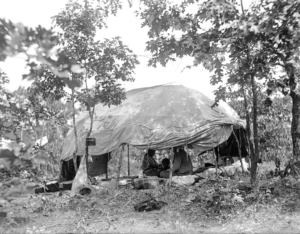More than a century before the Wisconsin Dells became the “Waterpark Capital of the World,” it was a famous tourist destination known for its scenic beauty. Guides began taking sightseers in rowboats along the Wisconsin River as early as the 1850s, and the first steamboats – packed with tourists – were launched in 1873. Cruising the Wisconsin River was the most popular way to view the rugged sandstone rock formations with names like Coldwater Canyon, Witches Gulch, and Fat Man’s Misery.
The Wauwatosa Historical Society holds an exceptional collection of glass plate negatives that show the Lefeber family vacationing in the Wisconsin Dells in 1909 and 1910. They owned and managed the large Lefeber Brothers Department Store at the corner of State Street and Harwood Avenue in downtown Wauwatosa, a suburb of Milwaukee. Father and son – James and Cornelius Lefeber – were prolific amateur photographers who enjoyed capturing images of their family and friends from about 1900 to 1935.
The photos show family members posed among the stunning rock formations; the women are clothed in fancy dresses and hats, and the men wear white button-down shirts with ties. One can only imagine the weight of their suitcases and the effort it took to pack and then board the train from Wauwatosa to Kilbourn City. (The name changed to Wisconsin Dells in 1931.)
Lefebers’ photographs present a view of the Wisconsin Dells of long ago – the river, the rock formations, the people, and the history. Today, over four million people vacation at the Wisconsin Dells each year. Although some visit only waterparks and souvenir shops, others cruise the Wisconsin River and enjoy the same vistas portrayed in Lefebers’ images.

Between 1865 and 1908, the images of H.H. Bennett attracted thousands of tourists to the Wisconsin Dells. The photograph of his son Ashley, titled “Leaping the Chasm,” (at left) and prints of his many other images were sold in cities nationwide. The Chicago, Milwaukee, and St. Paul Railroad used his images in pamphlets promoting tourism in the area.
Stereographs, produced by Bennett as early as 1868, were especially popular; the double images became three-dimensional when viewed through a hand-held stereoscope – a common form of entertainment in many middle-class households around the turn of the last century.
H.H. Bennett was a professional photographer who sold photographs to tourists and popular magazines. However, by the turn of the 20th century, hand-held cameras that used rolls of film were available to the vacationing public. Soon, tourists took their own photographs – instead of buying them from Bennett.
When the Lefebers visited the Wisconsin Dells in 1909 and 1910, hand-held cameras (like the Kodak Brownie) were inexpensive and readily available by mail order. James and Cornelius, however, preferred to use a bellows camera to record their vacations. To use a bellows camera, the photographer expands or contracts the bellows (the accordion-like piece that forms the camera’s center) to focus on a close-up or far-away image. Glass plate negatives, inserted into the back of the camera, record the image. Although it took some effort to pack and carry a bellows camera, a tripod, and boxes of glass plate negatives, the results were worth it. Lefebers’ images are clear, sharp, and detailed. And they have lasted over a century!
–Written by Carol Rosen, January 2024
Below you’ll find a selection of photographs from the Lefeber Glass Plate Collection at the Wauwatosa Historical Society. Click on the images to find out more about the photographs and the Lefeber family.
RELATED STORIES

OBJECT HISTORY: Lefebers’ Glass Plate Negatives

Wauwatosa’s Lefeber Brothers Department Store










